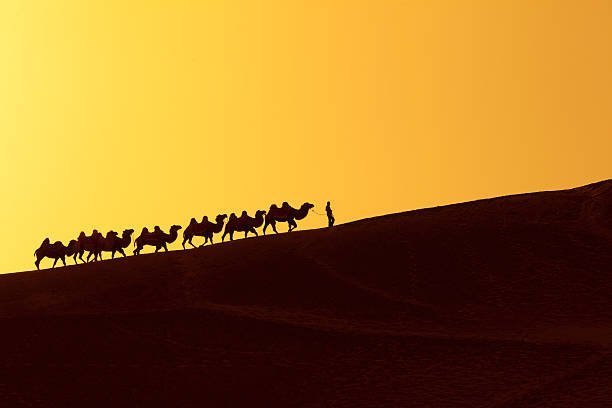
What was the Silk Road?
The Silk Road was a network of trade routes from China to Europe that ran from the second century BC until the mid-15th century. It went for more than 4,000 miles becoming the major route for economic, cultural, political, and religious interaction between the East and West.
Why was it called the Silk Road?
The Silk Road was named after the highly lucrative trade of silk textiles that travelled along it, which in those days were produced almost exclusively in China. Many other goods passed along it; however, the majority was Silk, and, of course, it is a great name that makes it sound exciting.
How did it work?
It started with a complicated series of small linked isolated halts where merchants traded goods to take further along the route. They were traded from one merchant to the next, who would then take them on to the next halt. The country was inhospitable, with bandits and marauding raiders, which meant that to make money these merchants had to be brave, cunning and resourceful. This meant that, due to these risks, few people went all the way along the Silk Road, one exception was the explorer, Marco Polo. In fact, it is from his diaries that a lot of what we know of the Silk Road comes. As you can imagine, over time, these markets became thriving towns and eventually, cities, as they grew into major trading centres. These little halts that grew and grew are now the major wealthy cities of Central Asia.
The Roll of the Silk Road in History
The Silk Road:
- opened political and economic relations between China, Korea, Japan, India, Iran, Europe, the Horn of Africa and Arabia.
- Produced an unprecedented exchange of ideas, religions, philosophies, and scientific discoveries, many of which were harmonised or reshaped by the societies that encountered them.
- It became a major migration route both ways for migrants, refugees, missionaries, artisans, diplomats, and even soldiers.
- Unfortunately, it bought diseases to Europe, such as the plague and is blamed to have brought the Black Death.
Why Did it end?
It was the rise of the Ottoman Empire in 1453, that ended it. They were in the middle between east and west and they cut the road in two. It is claimed that this is because the Ottomans didn’t like the idea of trade between the two, so they stopped it. I think they wanted to control it and tax it.
However, they weren’t successful as there was already another route, the Maritime Silk Road.
The Maritime Silk Road
The Maritime Silk Road was the seaborne version of the Silk Road, linking Southeast Asia, China, the Indian subcontinent and the Arabian peninsula to Europe.
It was a route first established in the 2nd century BC that by the 15th Century was flourishing. https://www.marineinsight.com/maritime-history/maritime-silk-routes-the-story-of-the-oldest-trade-routes/
Maritime trade routes
In fact, as a route for silk to reach Europe it had even started before the Silk Road. Originally it was a route to send silk from Asia to Europe and Africa. It went up the Red Sea, and at the top you would imagine that it travelled across the desert to the Mediterranean, but it didn’t.
You see, until 767AD, the boats used the Canal of the Pharaohs, which ran from the Red Sea across the desert to the Nile. The canal was built by general Ptolemy, who on the death of Alexander the Great, declared himself Pharaoh of Egypt and completed it around 274/273 BC. https://history-portal.com/canal-of-the-pharaohs/
The Maritime Silk Route worked because in those days’ sea was the most convenient way to move goods, something that is still true today.
Interestingly even though they believe that these routes were used to ship all kinds of goods, it was also called the ‘Marine Silk Road’. They believe that it got this name as silk was the major product shipped on these boats.
Others claimed that due to the number of ships being lost at sea the Marine Silk Road led to the development of the Silk Road.
These combined systems of marine and land became the most important route for trade between the East and West for centuries. These are the routes that even today, all these years later, are still in use and is how today’s global trade has prospered.
Today, they say we live in a global village, I would say it has always been one, it’s just that we didn’t realise it!
Isn’t History fun?
It’s fascinating to delve into the intricacies of the Silk Road and its maritime counterpart. Here are 10 more questions to explore the topic further:
- What were some of the key commodities traded along the Silk Road besides silk?
- How did the Silk Road contribute to the spread of religions such as Buddhism, Islam, and Christianity?
- Can you elaborate on the role of cultural exchange along the Silk Road? How did it influence art, architecture, and literature?
- Were there any notable cities along the Silk Road that served as major trading hubs? What made them significant?
- How did the Silk Road impact the development of technology and innovation in the regions it traversed?
- Were there any famous travelers or explorers besides Marco Polo who documented their journeys along the Silk Road?
- How did the Silk Road contribute to the growth of empires and the establishment of diplomatic relations between different regions?
- Can you discuss the significance of the Silk Road in shaping the economies of the civilizations it connected?
- Were there any environmental impacts associated with the Silk Road, such as changes in landscapes or ecosystems?
- How has the legacy of the Silk Road persisted in modern times, and are there any contemporary initiatives aimed at reviving its spirit of connectivity and exchange?
For more information click on:
https://www.history.com/topics/ancient-middle-east/silk-road
https://westportlibrary.libguides.com/silkroad
https://www.worldhistory.org/Silk_Road/
©Tony Dalton

